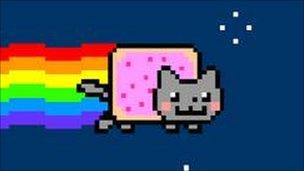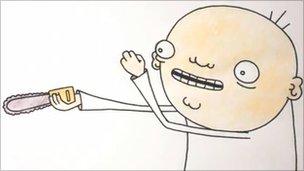The stuff that memes are made of
- Published
Tech Know's LJ Rich finds out whether her holiday video of a squirrel that chirps like a Star Trek communicator will be "memed"
Two men stand on a small stage in the cellar of a Soho bar. One is dressed as a cat and the other as a dog.
Doubtless other stages in Soho have hosted stranger sights, given the number of vice dens, cabaret joints and nightclubs that line the streets of this famously bohemian area of central London.
But the reason for them being on stage has more to do with the other industries Soho is famous for - media, advertising and movies.
The event being held in this cellar is Kitten Camp, a monthly meeting at which the most widely shared memes from the last few weeks are watched, laughed at and voted on.
Combat kitten
The memes are presented in an adversarial style with the cat and dog backing different ones. It is trend-to-trend combat, a kind of 8 out of 10 cats for the net set.

Made of pop tarts, poops rainbows - it's Nyan cat
This month's memes include, among other things, a cat made out of a pop tart, cats firing machine-guns, armed apes running amok, and the follow-on to planking - leisure diving, external.
The man in the cat costume is Kitten Camp organiser Chris Quigley. During the day he works at Rubber Republic, an ad agency that specialises in making viral content for the web. But once a month he dresses up as Jess The Cat to talk about memes.
Why a cat?
"Because the kitten is the king of memes," he said.
Bend and shape
To many people, viral content and memes look very similar. But for Mr Quigley and other initiates of this branch of internet culture there is a big, big difference.
Viral content, videos and stills, are those things we typically just pass unchanged to our friends via e-mail, Facebook updates or on message boards because they are funny, odd or everyone is talking about them.
Memes, on the other hand, are very different.
"A meme is a cultural thing that is re-mixed and changed by a community," said Mr Quigley.
Many people have seen the video known as Nyan cat featuring a cat made of a pop-tart that poops rainbows. That, in its initial form, was certainly viral in that it was endlessly passed around.
But many people have taken the original and mutated, morphed and altered it according to their own tastes. It has, in the parlance of this genre, been memed.
In many respects, nothing could be memed if it were not for the ready availability of the tools to manipulate images and edit videos. The web also makes it easier than ever before to pass these creations around and win an audience for them.
The creation of the content, be it video or image, is straightforward, but the winning of the audience for it is not.
In an attempt to uncover some of the dynamics of what makes a meme, L J Rich from the BBC's Click put up on YouTube a video, external she shot of a squirrel that makes an noise with an uncanny resemblance to the communicators from the original Star Trek.
It featured a cute animal, appealed to geeks and had a quirky appeal. All potentially fodder for a good meme, said Mr Quigley.
Meme weaver
Ms Rich enlisted the help of web veteran Joel Veitch from B3ta and Rather Good to turn the raw video into something more meme-able.
Mr Veitch has kicked off many a viral video and even a few memes, but even he is at a loss to explain what makes something get picked up, viewed and changed by millions.
"If there was an equation we could follow to generate success then we would all be rich," he said. "To this day I cannot say to any degree whether something will succeed."

Only after nine separate attempts did Tiny Chainsaw pick up a big audience
It can be frustrating for anyone who spends their time creating images, video clips or artwork they want to show off.
"No artist puts anything out that is just filler," he said. "Everything they do, they do because they think it is a good idea."
The painful truth is that the world wide web audience may not share that view.
Mr Veitch said there were some steps that could be taken to maximise the chances of something becoming a meme. Sometimes the recipe for success is persistence.
"Tiny Chainsaw was submitted to Reddit eight different times over the course of a few days," he said. "The ninth person to submit it got to the front page even though it was the same link."
A front page on Reddit is worth about 100,000 hits and those views helped the video find a big audience and give birth to a meme.
Mr Veitch's help with the squirrel video helped it rack up almost 16,000 page views. Plus it did get passed around a lot via e-mail, Facebook profiles and on blogs.
And, he said, just because it was not an immediate success did not mean it would never take off.
"Sometimes things just sit there for years before they take off," he said. "But having said that, that may not happen."
- Published18 August 2011
- Published29 June 2011
- Published19 May 2011
- Published30 March 2011